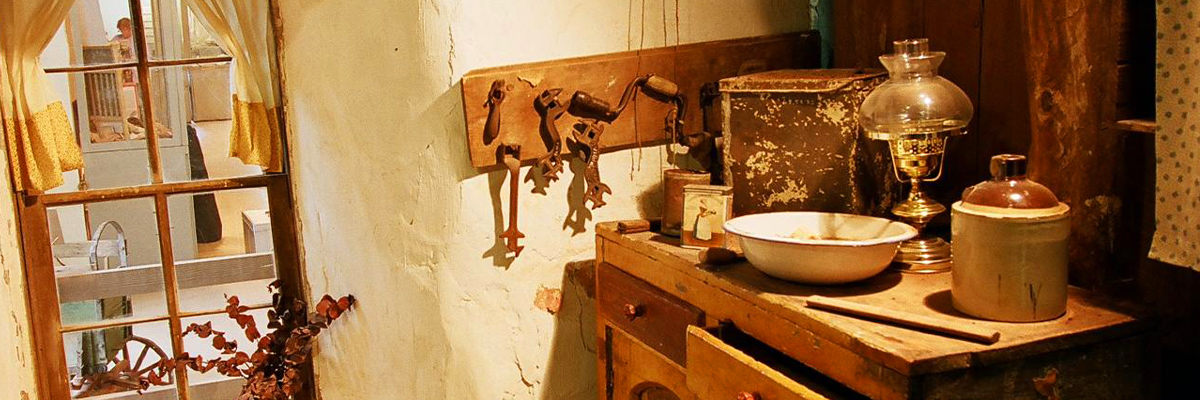
Sod House Museum
Sod House Museum
4628 State Highway 8
Aline, OK 73716
580-463-2441
sodhouse@history.ok.gov
Director: Renee Trindle
Hours
Tuesday, Wednesday, Friday and Saturday
9 a.m. to 5 p.m.
Thursday
10 a.m. to 5 p.m.
| Adults | $7 |
| Seniors (62+) | $5 |
| Students (6–18) | $4 |
| Family (up to 6 people) | $18 |
| Group Rate (10+) | $5/person |
| OHS Members, Children (under 6), Veterans and Active Military (with ID) | Free |

The Sod House Museum will be closed on Tuesday, April 8. During the month of April, we will open at 10 a.m. on Thursdays.
Sod House Museum seeks to preserve Oklahoma’s only remaining sod house and interprets the early-day lifestyles of a pioneer, from the establishment of the Cherokee Outlet in 1893 to 1920. The museum encloses the original sod house which is the key exhibit. Visitors can enjoy the experience of walking through the “soddy” and explore exhibits, artifacts, photographs, and a root cellar. The artifacts and exhibits portray the daily activities of the pioneers. Museum grounds include an additional building displaying horse-drawn equipment and period farm implements.
The museum offers exhibits, tours, educational programs, and events.
Marshal McCully and the Sod House
At one time, thousands of sod houses dotted the plains of North America. This two-room soddy, built by Marshal McCully in 1894, is the only remaining sod house Oklahoma that was built by a homesteader. McCully took part in the largest of Oklahoma’s land runs when the Cherokee Outlet opened for settlement at noon on September 16, 1893. McCully first lived in a one-room dugout, hollowed out of a ravine bank. He built the two-room sod house in August 1894 using blocks of the thick buffalo grass blanketing Oklahoma’s prairies.
McCully hitched his team to an fourteen-inch sod plow and split the grass into long rows. Using a flat shovel, he chopped the rows into eighteen-inch sections. He then laid the sod blocks like bricks to form the walls. To make the roof, McCully split poles from the few trees growing in the area and laid them across the top of the walls for rafters. Twelve inches of sod laid on the rafters completed the roof. Unlike many sod houses, McCully plastered the interior walls with alkali clay.
Marshal McCully received the homestead certificate for the land on April 15, 1902, and the patent on December 31, 1903. The McCully family lived in the sod house from 1894 until 1909 when they built a large two-story frame house. They continued to use the soddy for storage until 1963. On December 31, 1963, exactly sixty years after McCully received his patent, the Oklahoma Historical Society acquired the sod house.
Although the soddy remains in its original location, a cover now protects it from the elements. Visitors can walk through the furnished sod house and imagine what life was like for Oklahoma’s early settlers.
Farming in Early-Day Oklahoma
A steel beam rod-breaking plow is on display in the museum. This plowed a twelve-inch wide strip of sod four inches thick. The sod strips were then cut into sod blocks. It took one half-acre of sod to build the two-room sod house, a total of ninety-six tons of sod. It has been estimated that in the United States and Canada there were some one million sod buildings in use from 1903–13.
Oklahoma farmers produced a wide variety of crops including corn, cotton, winter wheat, oats, milo, maize, potatoes, sweet potatoes, peanuts, broomcorn, cowpeas, alfalfa, wild hay, and others. They also produced and sold poultry, eggs, cheese, butter, and garden/orchard products. The main crops by acreage and value, however, were corn, cotton, and winter wheat. An acre was the amount of land tillable by one man behind one ox in one day. Traditional acres were long and narrow due to the difficulty in turning the plow. One acre measures forty rods long and three rods wide.
In the 1890s it would have taken Marshal McCully forty to fifty hours of labor to produce one hundred bushels (five acres) of wheat with a gang plow, seeder, harrow, binder, thresher, wagons, and horses. By 1987, it took only three hours of labor to produce one hundred bushels (three acres) of wheat with a tractor, thirty-five-foot sweep disk, thirty-foot drill, twenty-five-foot self-propelled combine, and trucks. Farming has come a long way.





